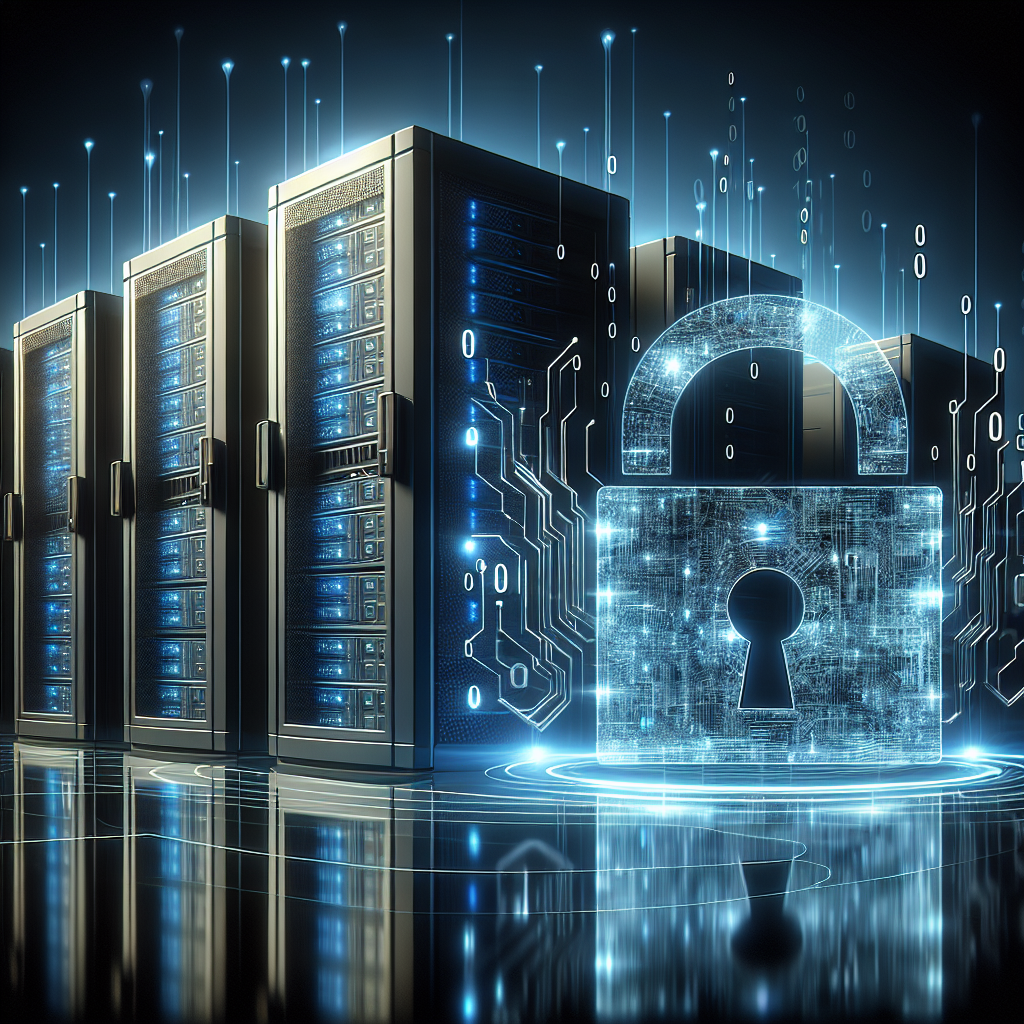Your cart is currently empty!
Tag: LongTerm

Ensuring Long-Term Success with Effective Data Center Lifecycle Management Strategies
In today’s digital age, data centers have become the backbone of businesses, enabling them to store, process, and manage vast amounts of data. With the increasing importance of data centers, it is essential for organizations to implement effective lifecycle management strategies to ensure long-term success.Data center lifecycle management involves the planning, design, construction, operation, and maintenance of data center facilities. By effectively managing each phase of the data center lifecycle, organizations can maximize efficiency, minimize downtime, and reduce costs.
One key aspect of data center lifecycle management is planning and design. Organizations need to carefully assess their current and future data center needs to ensure that the facility can support their business requirements. This includes considering factors such as power and cooling requirements, space constraints, and scalability.
During the construction phase, it is essential to work closely with architects, engineers, and construction teams to ensure that the data center is built to meet industry standards and best practices. This includes proper cabling, cooling systems, and backup power systems to ensure reliability and efficiency.
Once the data center is operational, organizations need to focus on day-to-day management and maintenance. This includes monitoring power usage, temperature levels, and equipment performance to identify potential issues before they escalate. Regular maintenance and upgrades are also essential to ensure that the data center remains efficient and reliable over time.
In addition to operational maintenance, organizations need to consider the end-of-life phase of the data center. This involves decommissioning old equipment, disposing of e-waste responsibly, and planning for the migration of data and applications to new facilities.
By implementing effective data center lifecycle management strategies, organizations can ensure the long-term success of their data center operations. This includes maximizing efficiency, reducing costs, and minimizing downtime. With proper planning, design, construction, operation, and maintenance, organizations can create a resilient and reliable data center infrastructure that can support their business needs for years to come.

Building Strong Partnerships with Data Center Vendors for Long-Term Success
In today’s fast-paced and constantly evolving business landscape, data centers play a critical role in ensuring the smooth functioning of organizations. Whether it’s storing and managing data, running critical applications, or ensuring cybersecurity, data centers are the backbone of modern businesses. As such, forging strong partnerships with data center vendors is crucial for long-term success.Building a strong partnership with a data center vendor goes beyond just signing a contract. It involves establishing a relationship based on trust, collaboration, and mutual understanding. By working closely with your data center vendor, you can ensure that your organization’s specific needs and requirements are met, and that you have access to the latest technology and services to support your business goals.
One of the key benefits of a strong partnership with a data center vendor is access to expertise and support. Data center vendors are experts in their field and can provide valuable insights and guidance on best practices, industry trends, and emerging technologies. By leveraging their expertise, you can make informed decisions that will help drive your business forward.
Additionally, building a strong partnership with a data center vendor can help streamline your operations and improve efficiency. By working closely with your vendor, you can optimize your data center infrastructure, ensure high performance and reliability, and reduce downtime. This can lead to cost savings, increased productivity, and a competitive edge in the market.
Another important aspect of building a strong partnership with a data center vendor is flexibility and scalability. As your business grows and evolves, your data center needs may change. A strong partnership with your vendor can ensure that your data center infrastructure can easily adapt to meet your changing requirements. Whether you need to scale up or down, add new services, or implement new technologies, your vendor can work with you to tailor solutions that fit your needs.
Finally, building a strong partnership with a data center vendor can help mitigate risks and enhance security. Data centers are prime targets for cyber-attacks and other security threats. By working closely with your vendor, you can implement robust security measures, regular audits, and compliance checks to ensure the safety and integrity of your data. Your vendor can provide guidance on security best practices and help you stay ahead of potential threats.
In conclusion, building a strong partnership with a data center vendor is essential for long-term success in today’s business environment. By establishing a relationship based on trust, collaboration, and mutual understanding, you can access expertise and support, streamline operations, improve efficiency, and enhance security. Ultimately, a strong partnership with your data center vendor can help drive your business forward and ensure that you stay competitive in the market.

Future-Proofing Your Data Center: Upgrading Cabling for Long-Term Success
In today’s fast-paced digital world, data centers play a crucial role in keeping businesses running smoothly. With the constant need for more storage, faster processing speeds, and increased connectivity, data centers must evolve to meet the demands of the future. One crucial aspect of future-proofing a data center is upgrading cabling to ensure long-term success.Upgrading cabling in a data center may seem like a daunting task, but it is essential for ensuring optimal performance and reliability. As technology continues to advance, outdated cabling infrastructure can become a bottleneck, limiting the data center’s ability to keep up with the increasing demands of modern applications and services.
One of the key reasons to upgrade cabling in a data center is to support higher data transfer speeds. With the proliferation of data-heavy applications like video streaming, cloud computing, and virtual reality, data centers must be able to handle large volumes of data quickly and efficiently. Upgrading to high-speed cabling, such as Category 6A or Category 8, can provide the necessary bandwidth to support these demanding applications and ensure smooth operation for years to come.
In addition to supporting higher data transfer speeds, upgrading cabling can also improve network reliability and reduce downtime. Outdated cabling infrastructure is more prone to performance issues and failures, which can result in costly downtime for businesses. By investing in newer, more reliable cabling technologies, data centers can minimize the risk of network outages and ensure uninterrupted operation for their critical applications and services.
Furthermore, upgrading cabling can also help future-proof a data center by preparing for emerging technologies like 5G, Internet of Things (IoT), and artificial intelligence. These technologies are expected to place even greater demands on data center infrastructure, requiring faster speeds, lower latency, and increased connectivity. By upgrading cabling now, data centers can position themselves to seamlessly integrate these technologies as they become more prevalent in the future.
When planning a cabling upgrade for a data center, it is essential to work with a knowledgeable and experienced cabling provider. They can help assess the current infrastructure, recommend the best cabling solutions for the specific needs of the data center, and ensure a smooth and efficient installation process. By partnering with a trusted cabling provider, businesses can rest assured that their data center is well-equipped to meet the demands of the future.
In conclusion, upgrading cabling is a crucial step in future-proofing a data center for long-term success. By investing in high-speed, reliable cabling technologies, businesses can ensure optimal performance, reduce downtime, and prepare for the challenges of tomorrow’s digital landscape. With the right cabling infrastructure in place, data centers can confidently navigate the ever-evolving technology landscape and continue to support the needs of their users and customers for years to come.

Critical Steps for Preventative Data Center Maintenance: Ensuring Long-Term Efficiency and Reliability
Data centers are the backbone of modern business operations, housing critical IT infrastructure and data that are essential for the smooth functioning of organizations. As such, it is crucial to ensure that data centers are properly maintained to prevent downtime and ensure long-term efficiency and reliability.Preventative maintenance is key to ensuring the optimal performance of data centers. By implementing a proactive maintenance strategy, organizations can identify and address potential issues before they escalate into major problems that can disrupt operations. Here are some critical steps for preventative data center maintenance:
1. Regular Inspections: Regular inspections of the data center infrastructure, including cooling systems, power distribution units, and cabling, are essential to identify any potential issues early on. Inspections should be conducted by qualified technicians who have a thorough understanding of data center operations.
2. Cleaning and Dusting: Dust and debris can accumulate in data center equipment, leading to overheating and potential equipment failure. Regular cleaning and dusting of equipment, including servers, switches, and cooling systems, can help prevent these issues and ensure the longevity of the equipment.
3. Temperature and Humidity Monitoring: Monitoring and maintaining optimal temperature and humidity levels in the data center are essential for preventing equipment overheating and ensuring the efficient operation of cooling systems. Regular monitoring of these levels can help identify any issues before they impact equipment performance.
4. Power Management: Proper power management is crucial for data center operations. Regularly checking power distribution units, UPS systems, and power cables can help prevent power outages and ensure the reliability of the data center infrastructure.
5. Software Updates and Patch Management: Keeping software and firmware up to date is essential for ensuring the security and performance of data center equipment. Regularly updating software and applying patches can help prevent security vulnerabilities and ensure the smooth operation of the data center.
6. Documentation and Asset Management: Maintaining accurate documentation of data center equipment, configurations, and maintenance activities is essential for tracking and managing the data center infrastructure effectively. Implementing an asset management system can help organizations keep track of equipment and plan for future upgrades and maintenance activities.
By following these critical steps for preventative data center maintenance, organizations can ensure the long-term efficiency and reliability of their data center operations. Preventative maintenance not only helps prevent downtime and equipment failure but also helps organizations optimize their data center performance and reduce operational costs. Investing in preventative maintenance is a wise decision for organizations looking to ensure the smooth functioning of their data center infrastructure.

Preventative Data Center Maintenance: Steps for Ensuring Long-Term Reliability and Performance
Data centers are the backbone of modern technology, housing the servers, storage, and networking equipment that keep businesses running smoothly. To ensure these critical systems operate at peak performance and reliability, preventative maintenance is essential.Preventative data center maintenance involves regular inspections, testing, and servicing of equipment to identify and address potential issues before they escalate into costly downtime or system failures. By following a comprehensive maintenance plan, data center operators can extend the lifespan of their equipment, minimize the risk of unexpected outages, and optimize performance.
Here are some key steps for ensuring long-term reliability and performance through preventative data center maintenance:
1. Develop a Maintenance Schedule: Establish a regular maintenance schedule that outlines the frequency and scope of inspections, testing, and servicing for each piece of equipment in the data center. This schedule should be based on manufacturer recommendations, industry best practices, and the specific needs of your data center.
2. Conduct Regular Inspections: Regularly inspect all equipment, including servers, UPS systems, cooling units, and electrical infrastructure, for signs of wear, damage, or malfunction. Look for loose connections, overheating components, unusual noises, or other indicators that equipment may be failing.
3. Test Equipment Performance: Perform routine performance tests on critical systems to ensure they are operating within specified parameters. This includes testing backup generators, UPS systems, cooling units, and fire suppression systems to verify they are ready to activate in the event of a power outage or emergency.
4. Clean and Maintain Equipment: Keep equipment clean and well-maintained to prevent dust buildup, overheating, and other potential issues. Regularly clean air filters, fans, and cooling coils to ensure proper airflow and cooling capacity.
5. Monitor Environmental Conditions: Monitor environmental conditions in the data center, including temperature, humidity, and air quality, to ensure they are within acceptable ranges for optimal equipment performance. Implement automated monitoring systems and alerts to quickly identify and address any deviations from normal operating conditions.
6. Document Maintenance Activities: Keep detailed records of all maintenance activities, including inspection reports, testing results, service logs, and equipment warranties. This documentation will help track maintenance history, identify trends, and make informed decisions about future maintenance needs.
7. Train Staff: Provide training for data center staff on proper maintenance procedures, safety protocols, and best practices for equipment care. Empower staff to identify and report maintenance issues promptly, and ensure they have the knowledge and resources to address minor maintenance tasks.
By following these preventative maintenance steps, data center operators can proactively manage the health and performance of their equipment, minimize the risk of downtime, and ensure long-term reliability. Investing in preventative maintenance now can save time, money, and headaches down the road by avoiding costly repairs and unplanned outages. With a well-planned and executed maintenance program, data centers can continue to support the evolving needs of their business and customers with confidence.

Non-Volatile Memory: A Sustainable Solution for Long-Term Data Retention
In today’s digital age, the importance of data retention cannot be understated. Whether it’s for personal use or business purposes, having access to stored data over the long term is crucial. However, traditional forms of data storage such as hard drives and flash memory have limitations when it comes to long-term data retention. This is where non-volatile memory comes into play as a sustainable solution for storing data over extended periods of time.Non-volatile memory, also known as NVM, is a type of computer memory that retains stored information even when the power is turned off. This is in contrast to volatile memory, such as RAM, which requires constant power to maintain data. Non-volatile memory is ideal for long-term data retention because it is not affected by power outages or system failures, ensuring that data remains intact and accessible over time.
One of the key benefits of non-volatile memory is its durability and reliability. Unlike traditional storage methods that can degrade over time, non-volatile memory has a much longer lifespan, making it a sustainable solution for storing data for years to come. This is particularly important for businesses that need to retain important records and information for compliance or legal reasons.
Another advantage of non-volatile memory is its energy efficiency. Because it does not require power to maintain stored data, non-volatile memory consumes less energy than volatile memory, making it a more sustainable option for long-term data retention. This not only helps reduce energy costs but also minimizes the environmental impact of data storage.
In addition to its durability and energy efficiency, non-volatile memory also offers fast access speeds and high performance, making it an ideal choice for applications that require quick retrieval of data. This is particularly important for businesses that rely on real-time data analysis and processing.
Overall, non-volatile memory is a sustainable solution for long-term data retention that offers durability, reliability, energy efficiency, and high performance. Whether you’re a business looking to store important records or an individual wanting to preserve memories, non-volatile memory provides a secure and efficient way to store data for the future. With the increasing importance of data retention in today’s digital world, non-volatile memory is a smart choice for ensuring that your information remains safe and accessible for years to come.

Building a Data Management Strategy for Long-Term Success
In today’s digital age, data has become one of the most valuable assets for businesses. From customer information to market trends, companies are constantly collecting and analyzing data to make informed decisions and drive their operations forward. However, managing this data effectively is crucial for long-term success.Building a data management strategy is essential for businesses looking to harness the power of their data and ensure its integrity, security, and usability. Without a solid strategy in place, companies risk losing valuable insights, facing regulatory issues, and compromising their competitive edge.
So, how can businesses build a data management strategy for long-term success? Here are some key steps to consider:
1. Define your data goals and objectives: Before you can effectively manage your data, you need to understand what you want to achieve with it. Define your data goals and objectives, such as improving customer satisfaction, increasing operational efficiency, or driving revenue growth. This will help guide your data management strategy and ensure that it aligns with your business objectives.
2. Identify your data sources and types: Next, identify the various sources of data within your organization, such as customer databases, sales records, and social media analytics. Determine the types of data you are collecting, including structured data (e.g., databases) and unstructured data (e.g., text files, images). Understanding the scope and nature of your data will help you develop a plan for managing and leveraging it effectively.
3. Implement data quality and governance practices: Data quality is crucial for ensuring the accuracy, consistency, and reliability of your data. Implement data quality practices, such as data profiling, cleansing, and validation, to maintain the integrity of your data. Additionally, establish data governance practices to define roles and responsibilities for managing data, as well as policies and procedures for data access, security, and privacy.
4. Invest in data storage and infrastructure: To effectively manage and analyze your data, you need the right storage and infrastructure in place. Consider investing in cloud-based storage solutions, data warehouses, and analytics tools to store, process, and visualize your data efficiently. Ensure that your infrastructure is scalable, secure, and compliant with data regulations.
5. Develop a data lifecycle management strategy: Data has a lifecycle, from creation and storage to analysis and archiving. Develop a data lifecycle management strategy to govern how data is handled at each stage of its lifecycle. Define retention policies, data backup procedures, and data archival practices to ensure that your data is managed effectively over time.
6. Monitor and measure your data management performance: Finally, monitor and measure the performance of your data management strategy to ensure its effectiveness and identify areas for improvement. Use key performance indicators (KPIs) to track data quality, governance compliance, and overall data management efficiency. Regularly review and update your strategy to adapt to changing business needs and technology trends.
In conclusion, building a data management strategy is essential for long-term success in today’s data-driven business environment. By defining your data goals, identifying data sources, implementing data quality and governance practices, investing in storage and infrastructure, developing a data lifecycle management strategy, and monitoring performance, you can effectively manage and leverage your data for strategic decision-making and operational excellence. Start building your data management strategy today to unlock the full potential of your data assets and drive your business forward.

Why Business Continuity Is Essential for Long-Term Success
In today’s fast-paced and constantly evolving business world, the need for effective business continuity planning has become more crucial than ever before. Business continuity refers to the processes and procedures put in place to ensure that a company can continue to operate in the event of a disruption or disaster.There are many reasons why business continuity is essential for long-term success. First and foremost, having a solid business continuity plan in place can help minimize the impact of disruptions on a company’s operations and finances. Whether it’s a natural disaster, a cyber-attack, or a pandemic, having a plan in place can help a company quickly recover and resume normal operations.
Furthermore, having a business continuity plan can help build trust and confidence among customers, suppliers, and other stakeholders. Knowing that a company has measures in place to ensure business operations can continue even in the face of adversity can help instill confidence in the company’s ability to deliver products and services consistently.
Business continuity planning also helps companies comply with regulatory requirements and industry standards. Many industries have regulations in place that require companies to have business continuity plans to protect data, ensure customer safety, and maintain operations. Failure to comply with these regulations can result in fines, legal action, and damage to a company’s reputation.
Additionally, having a business continuity plan can help companies identify and mitigate potential risks before they escalate into full-blown crises. By conducting risk assessments and developing contingency plans, companies can proactively address vulnerabilities and reduce the likelihood of disruptions occurring in the first place.
Ultimately, investing in business continuity planning is an investment in the long-term success and sustainability of a company. By being prepared for the unexpected, companies can minimize downtime, protect their reputation, and ensure that they can continue to serve their customers and achieve their business goals even in the face of adversity. In today’s unpredictable business environment, having a robust business continuity plan is not just a good idea, it’s a necessity for long-term success.

Why Business Continuity is Essential for Long-Term Success
In today’s fast-paced and ever-changing business environment, having a solid business continuity plan is essential for long-term success. Business continuity refers to the ability of an organization to continue operating during and after a disruption, such as a natural disaster, cyber attack, or other unforeseen event. By having a plan in place to ensure the continuity of operations, businesses can minimize the impact of disruptions and maintain their competitive edge.One of the main reasons why business continuity is essential for long-term success is that it helps to protect a company’s reputation. In the event of a disruption, customers and clients expect businesses to continue providing products or services without interruption. If a company is unable to do so, it can damage its reputation and lose customers to competitors. By having a business continuity plan in place, businesses can demonstrate their commitment to serving their customers and maintaining their trust, even in the face of adversity.
Business continuity also helps to mitigate financial risks. Disruptions can be costly for businesses, resulting in lost revenue, increased expenses, and potential legal liabilities. By having a plan in place to address potential disruptions, businesses can minimize the financial impact and ensure that they are able to recover quickly and efficiently. This can help businesses avoid significant financial losses and maintain their profitability in the long run.
Additionally, business continuity can help businesses comply with regulatory requirements. Many industries have strict regulations governing business operations, particularly in terms of data security and privacy. By having a business continuity plan that addresses these regulatory requirements, businesses can ensure that they remain in compliance and avoid costly fines or legal actions.
Furthermore, business continuity can help businesses stay ahead of their competitors. In today’s competitive marketplace, customers expect businesses to be reliable and responsive, regardless of external disruptions. Businesses that are able to maintain operations during a disruption can gain a competitive advantage over their competitors, as customers are more likely to trust and continue doing business with a company that can demonstrate its ability to weather the storm.
In conclusion, business continuity is essential for long-term success because it helps to protect a company’s reputation, mitigate financial risks, comply with regulatory requirements, and stay ahead of competitors. By having a solid business continuity plan in place, businesses can ensure that they are able to continue operating in the face of disruptions and maintain their competitive edge in today’s fast-paced business environment.

Investing in Data Center Security Systems: A Wise Decision for Long-Term Data Protection
In today’s digital age, data has become one of the most valuable assets for businesses. From customer information to financial records, companies rely on data to drive their operations and make informed decisions. However, with the increasing amount of data being generated and stored, the need for robust security measures has never been greater. Investing in data center security systems is a wise decision for long-term data protection.Data center security systems are designed to safeguard sensitive information from unauthorized access, theft, or tampering. These systems consist of a combination of physical and digital security measures to ensure the integrity and confidentiality of data stored in a data center. Some common security features include access control systems, surveillance cameras, firewalls, encryption, and intrusion detection systems.
By investing in data center security systems, businesses can mitigate the risk of data breaches and protect their valuable assets. Data breaches can have severe consequences for a company, including financial losses, damage to reputation, and legal liabilities. In fact, the average cost of a data breach for businesses in 2020 was $3.86 million, according to a study by IBM Security.
Furthermore, data center security systems can also help businesses comply with data protection regulations such as the General Data Protection Regulation (GDPR) and the Health Insurance Portability and Accountability Act (HIPAA). Failure to comply with these regulations can result in hefty fines and penalties, as well as damage to a company’s reputation.
In addition to protecting data from external threats, data center security systems can also protect against internal threats. Insider threats, whether intentional or unintentional, can pose a significant risk to data security. By implementing access control systems and monitoring tools, businesses can detect and prevent unauthorized access to sensitive information.
Investing in data center security systems is not only a proactive measure to protect data, but also a long-term investment in the success and sustainability of a business. By prioritizing data security, businesses can build trust with customers, partners, and stakeholders, demonstrating their commitment to protecting sensitive information.
In conclusion, investing in data center security systems is a wise decision for long-term data protection. With the increasing prevalence of data breaches and cyber threats, businesses cannot afford to overlook the importance of securing their data assets. By implementing robust security measures, businesses can safeguard their data, comply with regulations, and mitigate risks, ultimately ensuring the longevity and success of their operations.
